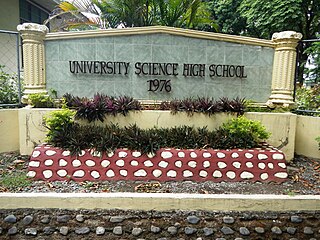Related Research Articles

The University of the Philippines is a state university system in the Philippines. It is the country's national university, as mandated by Republic Act No. 9500, giving it institutional autonomy.

The University of the Philippines Diliman, also referred to as UP Diliman or simply University of the Philippines (UP), is a public, coeducational, research university located in Diliman, Quezon City, Philippines. It was established on February 12, 1949, as the flagship campus and seat of administration of the University of the Philippines System, the premier and national university of the Philippines.

The University of the Philippines Los Baños, also referred to as UP Los Baños or colloquially as Elbi, is a public research university primarily located in the towns of Los Baños and Bay in the province of Laguna, some 65 kilometers southeast of Manila. It traces its roots to the UP College of Agriculture (UPCA), which was founded in 1909 by the American colonial government to promote agricultural education and research in the Philippines. American botanist Edwin Copeland served as its first dean. UPLB was formally established in 1972 following the union of UPCA with four other Los Baños and Diliman-based University of the Philippines (UP) units.

Quezon City Science High School is the Regional Science High School for the National Capital Region. It is the premier science high school of Quezon City, and is regarded as one of the prestigious sciences triumvirate of the Republic of the Philippines along with the Philippine Science High School and Manila Science High School. It is located at Golden Acres Road, Corner Misamis Street, Bago-Bantay, Quezon City, Philippines. Founded in September 17, 1967, it was appointed as the Regional Science High School for the National Capital Region since 1998.
University admission or college admission is the process through which students enter tertiary education at universities and colleges. Systems vary widely from country to country, and sometimes from institution to institution.

The University of the Philippines Manila is a public, coeducational, research university located in Ermita, Manila, Philippines. It is known for being the country's center of excellence in the health sciences, including health professional education, training, and research. It is the oldest of eight constituent universities of the University of the Philippines System, and predates the founding of UP by three years. It was originally established on December 1, 1905, as the Philippine Medical School and later renamed as the UP College of Medicine and Surgery on June 10, 1907. In 1983 it was renamed as University of the Philippines Manila.
College application is the process by which individuals apply to gain entry into a college or university. Although specific details vary by country and institution, applications generally require basic background information of the applicant, such as family background, and academic or qualifying exam details such as grade point average in secondary school and standardized testing scores.

The Nationwide Unified Examination for Admissions to General Universities and Colleges (普通高等学校招生全国统一考试), commonly abbreviated as Gaokao, is the annual national undergraduate admission exam of China, held in early June. The exam is held by provincial governments under directions from the Ministry of Education and is required for undergraduate admissions to all higher education institutions in the country. The Gaokao is taken by high school seniors at the end of their final year.

Regional Science High School for Region 1 (RSHS) is a Magnet school of the Department of Education (Philippines), established in 1994 by virtue of DECS Order No. 69,s.1993. The school has a curriculum that specializes in science and research.

The Oblation Run is an annual event held by the University of the Philippines (UP) and Polytechnic University of the Philippines (PUP) chapters of Alpha Phi Omega (APO) on the PUP and different UP campuses. The runners are male, and traditionally run completely naked in public places, with their genitals fully visible, on a designated route. The event was first organized in 1977 at the University of the Philippines Diliman to promote Hubad na Bayani, a film. It draws its name from the Oblation, a statue of a nude man located in every University of the Philippines campus, which symbolizes "a selfless offering of one's self to the country." The event is usually done on December 16, and serves as a protest to contemporary national issues.

The School of Library and Information Studies of the University of the Philippines or UP SLIS is the oldest library school in the Philippines. Formally established in March 1961 as the Institute of Library Science, it can trace it roots to 1914, making it one of the first library schools in Asia. It is an independent degree-granting unit of the University of the Philippines Diliman, and offers programs in the field of library and information science. In December 2015, the Commission on Higher Education declared the school as the first and only Center of Excellence among universities and colleges with library and information programs in the Philippines.

University Science High School, referred to as Central Luzon State University Science High School or USHS, is a science high school located inside the campus of Central Luzon State University (CLSU), in Muñoz, Nueva Ecija, Philippines. USHS is not included in the Philippine Science High School System and is under the College of Education of the Central Luzon State University.
Mikaela Irene Dimaano Fudolig is a Filipino physicist and former child prodigy. She is known for earning her undergraduate degree at the age of 16.
The Polytechnic University of the Philippines College Entrance Test, commonly known as PUPCET, is part of the admission requirements in the Polytechnic University of the Philippines, administered to graduates of Philippine and foreign high schools. It is used to measure the capability of incoming students depending on what degree will the applicant choose. PUPCET is one of the most competitive entrance examinations in the Philippines. Of an estimated 50,000 annual entrance test examinees for the main campus in Manila, only 8,000 will be accepted due to the university's limited budget. Due to covid restrictions this temporarily suspended and implements College Admission Evaluation of Polytechnic University of the Philippines or CAEPUP.

The University of the Philippines College of Law is the law school of the University of the Philippines Diliman. Formally established in 1911 in UP Manila, it is the third oldest continually-operating law school in the Philippines. Since 1948, it has been based in UP Diliman in Quezon City, the flagship of the UP System's eight constituent universities. The college also holds extension classes at the Bonifacio Global City campus of UP Diliman in Taguig and the Iloilo City campus of UP Visayas.

The University of the Philippines Manila College of Medicine (CM) is the medical school of the University of the Philippines Manila, the oldest constituent university of the University of the Philippines System. Its establishment in 1905 antedates the foundation of the UP System and makes it one of the oldest medical schools in the country. The Philippine General Hospital, the national university hospital, serves as its teaching hospital.
Federal Institute of Science And Technology (FISAT) is a private engineering college and business school in Mookkannoor, Kerala, India, run by the Federal Bank Officers' Association Educational Society (FBOAES), established in 2002. It is an initiative of the Federal Bank Officers' Association (FBOA), the organisation representing the officers of the Federal Bank. FISAT is accredited by NBA and NAAC.
Philippine Science High School - Soccsksargen Region Campus (PSHS-SRC), situated at Brgy. Paraiso, Koronadal City, is the 12th campus of the Philippine Science High School System which admits and grants scholarships to students who are gifted in science and mathematics all over Soccsksargen and neighboring places. Admission to this campus is by passing the National Competitive Examination organized and conducted by the PSHS System annually and only Filipino citizens are qualified to attend. Soccsksargen covers the provinces of South Cotabato, North Cotabato, Sarangani and Sultan Kudarat. The PSHS-SRC formally opened on June 17, 2013 with 52 scholars comprising as the pioneering batch.
The Philippine Science High School - Calabarzon Region Campus (PSHS-CALABARZONRC) is the 14th campus of the Philippine Science High School System located at Brgy. Sampaga, Batangas City. The campus specializes in Integrated Sciences, Mathematics, and Computer Sciences while still pertaining to the standard humanitarian subjects such as Physical Education and Music. The school's expansive and intensive nature of studies along with skilled and handpicked teachers has garnered it a reputation of producing some of the best students in the field of Science and Mathematics in both the region and the Philippines. The campus, having only started its groundbreaking ceremony on March 10, 2016, is still under construction with multiple unfinished facilities.
The Alpha Phi BetaFraternity is a fraternity based in the University of the Philippines College of Law with no recognized chapters outside University of the Philippines Diliman. The fraternity's membership hails from the College of Law and from pre-law colleges in the campus. 2019 marked the fraternity's 80th Anniversary. It is one of the three fraternities based in the college, the other two being Sigma Rho fraternity and Scintilla Juris.
References
- ↑ de Santos, Jonathan (2014-08-17). "Is it time for UP to abandon the UPCAT?". GMA News Online. Retrieved 2023-06-06.
- ↑ "Excellence and Equity: UP's Great Balancing Act (UPG)". upcatreview.com. 14 December 2011.
- ↑ "UPCAT (UP Office of Admissions)".
- ↑ "More than 99% of UPCAT passers come from private schools". 22 September 2016.
- 1 2 3 Mateo, Janvic (2019-04-02). "11,821 pass University of the Philippines College Admission Test". philstar.com. Retrieved 2019-04-09.
- ↑ "Data Privacy Act Primer". 29 March 2017.
- ↑ "UPCAT Online". UPCAT Online. Retrieved 2019-04-09.
- ↑ Tan, Maria (2023-06-23). "Isko and Iska hopefuls take the UPCAT". ABS-CBN News. Retrieved 2023-06-04.
- ↑ Mateo, Janvic (2023-06-04). "UPCAT back after 3 years". Philippine Star. Retrieved 2023-06-04.
- ↑ Magcamit, Mary Rose (2012-04-29). "A scholar with scholars". INQUIRER.net. Retrieved 2023-06-06.
- ↑ UP Diliman Class of 2007 has 8 top honors. University of the Philippines Diliman. Archived from the original on 29 September 2017.